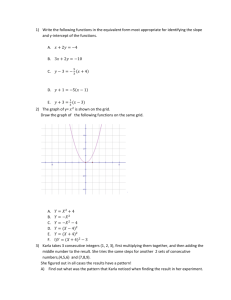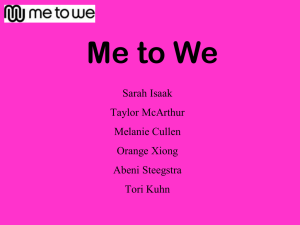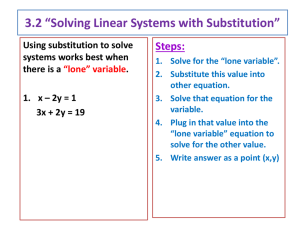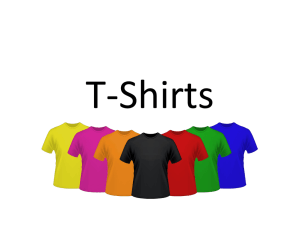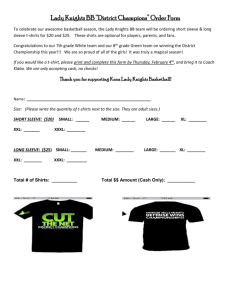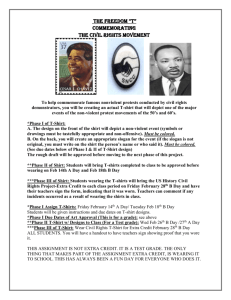t-shirts
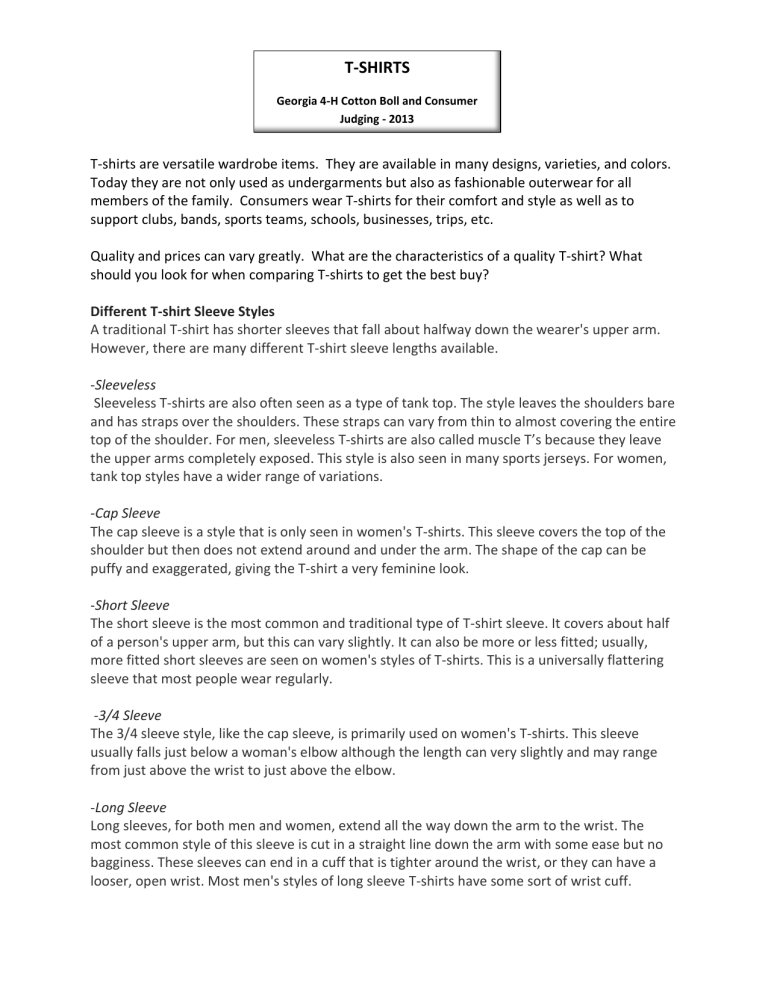
T-SHIRTS
Georgia 4-H Cotton Boll and Consumer
Judging - 2013
T-shirts are versatile wardrobe items. They are available in many designs, varieties, and colors.
Today they are not only used as undergarments but also as fashionable outerwear for all members of the family. Consumers wear T-shirts for their comfort and style as well as to support clubs, bands, sports teams, schools, businesses, trips, etc.
Quality and prices can vary greatly. What are the characteristics of a quality T-shirt? What should you look for when comparing T-shirts to get the best buy?
Different T-shirt Sleeve Styles
A traditional T-shirt has shorter sleeves that fall about halfway down the wearer's upper arm.
However, there are many different T-shirt sleeve lengths available.
-Sleeveless
Sleeveless T-shirts are also often seen as a type of tank top. The style leaves the shoulders bare and has straps over the shoulders. These straps can vary from thin to almost covering the entire top of the shoulder. For men, sleeveless T-shirts are also called muscle T’s because they leave the upper arms completely exposed. This style is also seen in many sports jerseys. For women, tank top styles have a wider range of variations.
-Cap Sleeve
The cap sleeve is a style that is only seen in women's T-shirts. This sleeve covers the top of the shoulder but then does not extend around and under the arm. The shape of the cap can be puffy and exaggerated, giving the T-shirt a very feminine look.
-Short Sleeve
The short sleeve is the most common and traditional type of T-shirt sleeve. It covers about half of a person's upper arm, but this can vary slightly. It can also be more or less fitted; usually, more fitted short sleeves are seen on women's styles of T-shirts. This is a universally flattering sleeve that most people wear regularly.
3/4 Sleeve
The 3/4 sleeve style, like the cap sleeve, is primarily used on women's T-shirts. This sleeve usually falls just below a woman's elbow although the length can very slightly and may range from just above the wrist to just above the elbow.
Long Sleeve
Long sleeves, for both men and women, extend all the way down the arm to the wrist. The most common style of this sleeve is cut in a straight line down the arm with some ease but no bagginess. These sleeves can end in a cuff that is tighter around the wrist, or they can have a looser, open wrist. Most men's styles of long sleeve T-shirts have some sort of wrist cuff.
-Raglan Sleeve
A raglan sleeve does not refer to a length of sleeve but rather a style. This distinctive look is also referred to as a baseball T-shirt because the style is used in most baseball uniforms. In this style, the sleeve is attached to the shirt on a diagonal instead of a straight up-and-down seam.
Often, this style uses different colors of fabric for the sleeve and the bodice to emphasize the lines. This look is most often associated with a sporty style for both men and women.
Different Kinds of T-Shirt Styles
Basic / Classic - A basic T-shirt generally refers to a T-shirt that is one uniform color or pattern throughout. A basic T-shirt can be found in any sleeve style and for both men and women.
These can also come in longer lengths or tall sizes for men or women.
Graphic A graphic T-shirt is one that has an image printed onto the fabric. This is a very popular style for both men and women. Often, images are screen printed, which leaves a layer of ink on top of the fabric, but some styles may directly dye the fabric to create an image or words
Embellished - Embellished T-shirts are T-shirts that have been decorated with a medium other than ink. These are especially popular with women because many embellishments use rhinestones, sparkles, lace, bows, or studs. Lace may be added along sleeves or on seams, or studs and beads can cover the shoulders or form abstract patterns.
T-Shirt Neck Shapes
The shape of a T-shirt's neckline also varies. Often, men and women find the choice of a neckline to be determined by a combination of comfort as well as style.
-Round Necklines - The round neckline is the most traditional and common T-shirt neckline. It sits just under the base of the wearer's neck.
-V-Necks- V-neck T-shirts form a pointed V at the neck. This gives the neck a little more space, and it also looks a little more stylized than the basic round neckline.
-Scoop Necklines - The scoop neckline is almost primarily used on women's T-shirts. This neckline is a wide and low rounded shape, often falling around or below the woman's clavicle
T-Shirt Fit
T-shirt fits for both men and women can vary. Most men prefer a fitted but still loose T-shirt fit that is not too clingy or tight. Many men also wear loose and baggy T-shirts. Women's T-shirts can be specially designed with curved seams to fit a woman's body snugly since the straight sides of a regular T-shirt can be unflattering for some women.
Fabric Construction
Select a T-shirt that will keep its shape and not be shorter and wider after laundering. The structure of the knit is the determining factor. Look for shirts with firm, even close knitting.
Examine the knit structure closely. The tiny loops should be round and plump, not stretched and pulled into long thin shapes. If they are stretched, once the garment is laundered, the loops return to their normal round shape and the garment becomes shorter.
Look for round loops (Figure A). Avoid T-shirts with Stretched loops (Figure B). Remember, the rounder the loops, the better chance that the knit will retain its shape through many washings.
Figure A. Figure B.
Garment Cut
The garment should be cut with the grain. The vertical loops will be at right angles to the lower edge rather than distorted. The side seams will be in correct position rather than twisted to the front or back. If the garment is cut improperly, it will remain twisted and out of shape after washing.
Often, T-shirt bodies without side seams are cut from circular knit tubes. Check for evenness of
"grain" and a smooth rather than twisted garment body. Look at how the sleeves are cut. They should be of sufficient size and ease to not bind the wearer nor appear twisted in the armhole.
Fabrics
The fabric for T-shirts may be cotton, polyester, rayon or blends of several fibers.
Four common types on the market today are:
-100% Cotton – Affordable, and can be dyed or printed easily. However, 100% cotton T-shirts sometimes shrink when washed.
-100% Ringspun Cotton – Thinner and softer than normal 100% cotton basics; often called
“fashion tees”.
-50% Cotton/50% Polyester Blend – Softer than 100% cotton and will not shrink as much.
-Triblend – Blend of 50% Cotton/25% Polyester/25% Rayon - Extremely soft but expensive.
Fabrics made of cotton, or a blend with a large percentage of cotton, will be cooler to wear than 100% synthetic fabrics. If purchasing T-shirts for outdoor winter wear, one might select synthetic or other fabrics for warmth.
Shrink Resistance and Special Finishes
T-shirts should be shrink resistant to one or two percent to maintain proper size. All-cotton T-
shirts, even high quality ones, if unfinished, may shrink as much as five percent which is more than a size change. So buy a larger size to compensate for such shrinkage. Blended T-shirts tend to shrink less. New finishes and processing treatments for knits are creating products that will not shrink, or shrink only minimally. Read information given on labels or packaging to note shrink resistance and guarantees. These processes mean you can buy T-shirts according to your size and fit rather than buying a larger size to allow for shrinkage.
Garment Construction
Examine T-shirts for overall smooth, even stitching with no drawing of seams. Top-stitching should be flat and straight without broken stitches. Neckband and sleeve edge finishes should be even and smooth. Hems should not show, or else be top-stitched as part of the garment design. Back, shoulder and neck seams should be reinforced with tape to help retain shape.
Seams should be serged (overcast) or zig-zagged to lie flat yet have give.
Necklines
The style and design of the neckline is important. If a crew neckline is used, be sure it will stretch enough to go over your head. Be sure it returns to its original shape and lies smoothly and comfortably around the neck. A line of stitching is sometimes sewn across the back of the neckline to help the neckline hold its shape. A popular finish for the neckline and sleeve edge on a girl's T-shirt is an embroidered or cut-work design. The stitching should be smoothly finished with no loose threads dangling. This finish is not very durable and often loses its shape after only one or two washings unless the embroidered area is interfaced with a lightweight woven fabric.
Shoulders
Check the T-shirt's shoulder seams for reinforcement tape. This tape, sewn into the seams, will help the shoulders to keep their shape. It will also prevent excess strain on the seam which could otherwise cause “runs” in the fabric.
Seams
Seams in a T-shirt are generally very narrow and are sewn with a stretchy overcast (serge) seam
Check carefully along seam lines for small holes caused by a dull needle. These holes can cause
“runs” in the fabric. Some single knit shirts do not have side seams. The fabric is knitted in a tube and does not require seams. If there are side seams, they should hang perpendicular to the hemline of the shirt. Check by holding the shirt at the shoulders and shaking it out flat.
Notice the position of the side seams. If the seams twist toward the center, the shirt will be less comfortable to wear.
Hems
Hems may be finished in a number of ways. A machine blind hem is often used. Be sure it is smooth and that the stitches are not too conspicuous on the right side of the garment. If a machine straight stitch is used to hem the garment, be sure there is some stretch so the hem stitches won't break easily.
Sleeves
Most T-shirt sleeves have hems similar to the regular hem at the bottom of the shirt. However, some T-shirts use the same type ribbing for the neckline and the sleeve. If ribbing is used, be sure the ribbing stretches enough to be put on easily and regains its shape quickly. It should fit smoothly without binding when worn.
Caring for T-shirts
Caring for your T-shirts is easy and simple. Always follow the manufacturer's instructions on the care label. Some T-shirts can be machine washed in hot or warm water and tumble dried; others may require more special care such as machine washing in cold water and line drying or lying flat to dry. Shirts in rich, deep colors usually require washing separately in cool water.
Decorative tees with transfer prints generally specify special care, such as turning the T-shirt wrong side out before laundering. Remember, to maintain garment appearance, you must follow care recommendations. Consider the care you are willing to give before buying the garment.
Shrinkage in knit T-shirts can be a problem. Cotton knits tend to shrink unless they have a special finish. Check the label to determine finishes used and the amount of shrinkage that can be expected. Almost all T-shirt fabrics are prewashed to prevent shrinkage. Check the label and/or hangtag for manufacturer's information. Many people like to bleach their T-shirts to remove stains and dinginess. Always check the care label to see if bleach is recommended or not. Many colors will fade if bleach is used, so check the care label for directions. Take good care of your T-shirts and they will last longer and wear better.
Costs
T-shirts are usually inexpensive but price can range due to fabric, embellishments and purchase point. Higher quality T-shirts may cost more money. Check the quality of the knit fabric, construction of the garment, required care and features to make sure that the T-shirt is durable and worthy of your money. Purchase the best quality for your individual needs and your budget.
Prepared by: Cheryl R. Varnadoe, University of Georgia, Extension 4-H Specialist, May, 2013
Sources:
Ebay T-Shirt Buying Guide
Georgia 4-H T-Shirts Cotton Boll and Consumer Judging Study Guide– 2007
How To Buy T-shirts – Ohio State University Extension and Michigan State University Extension

